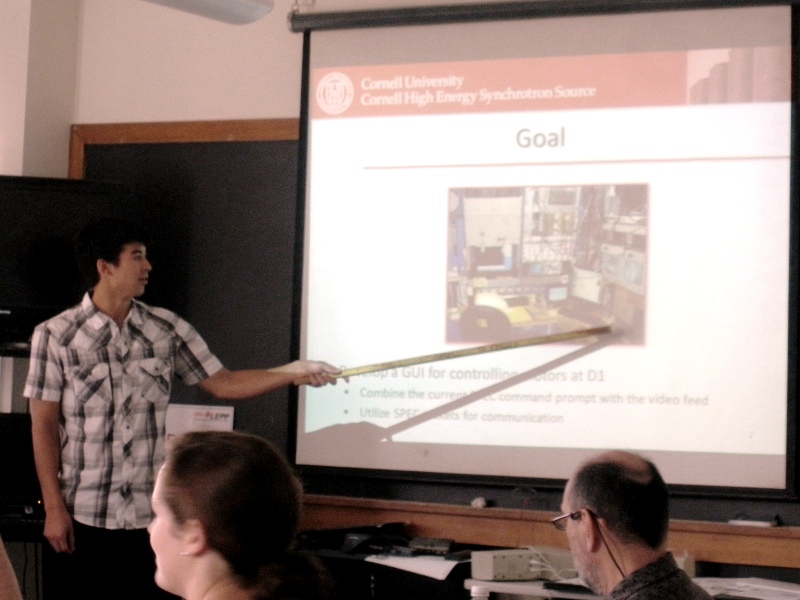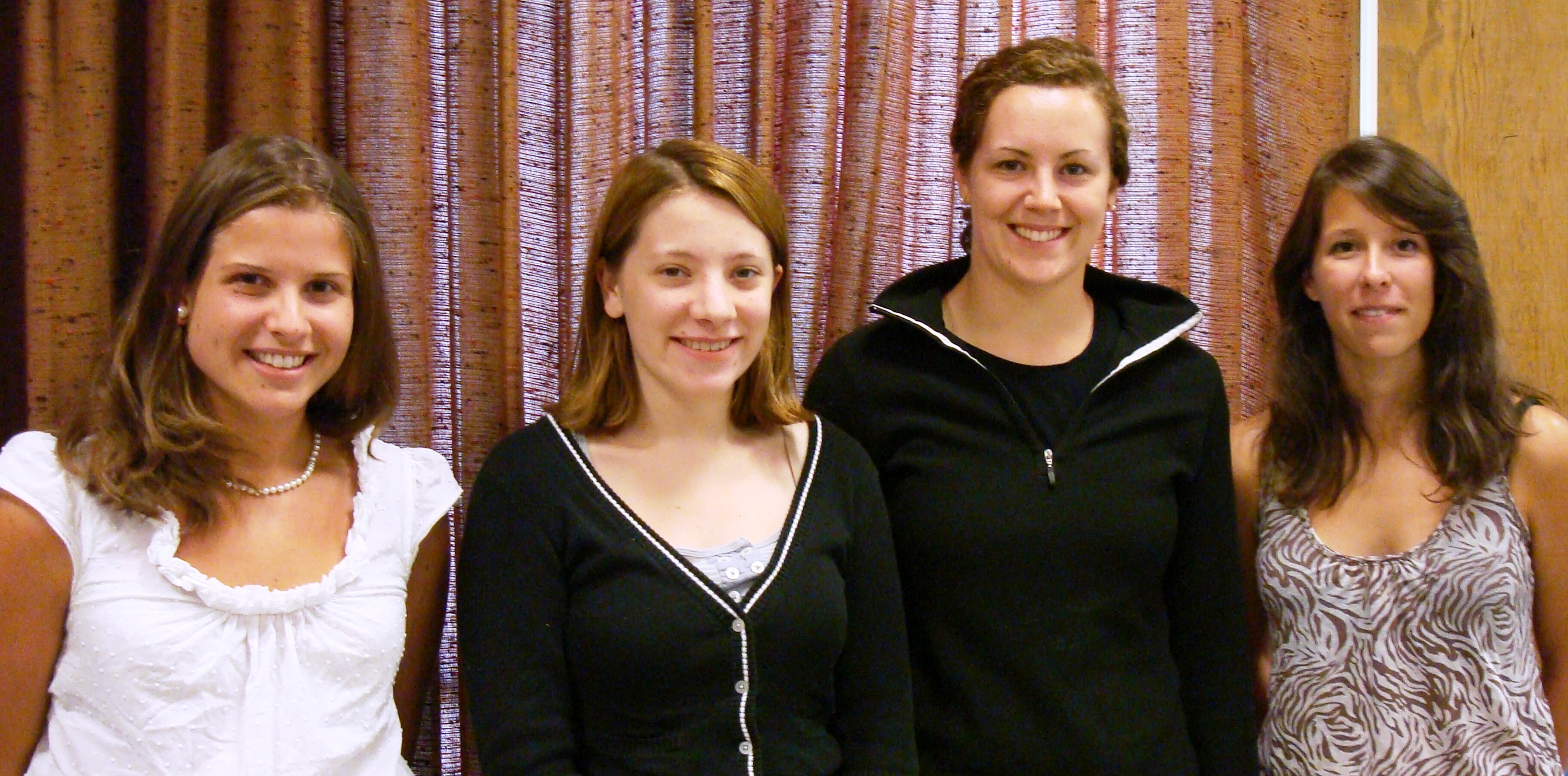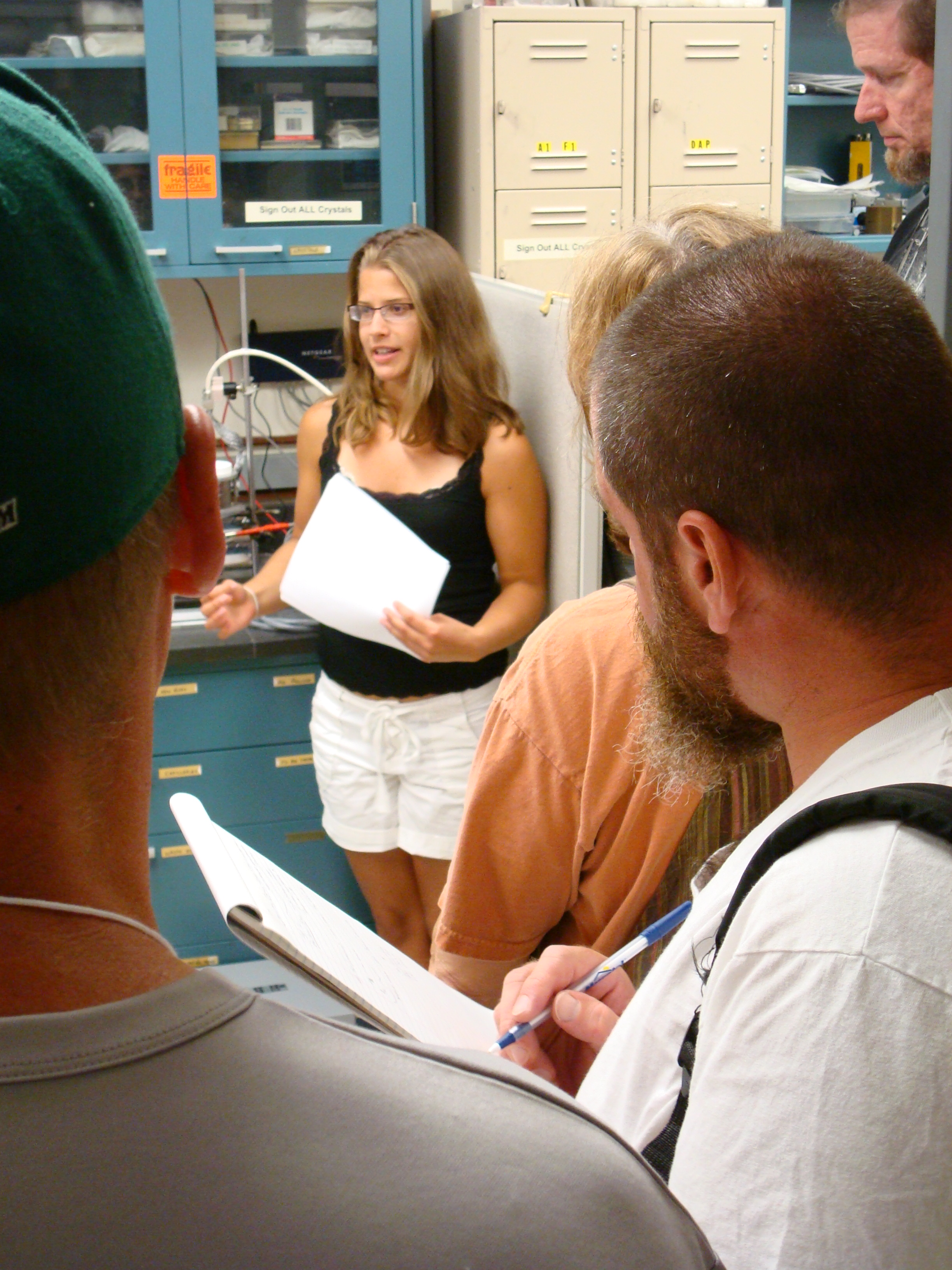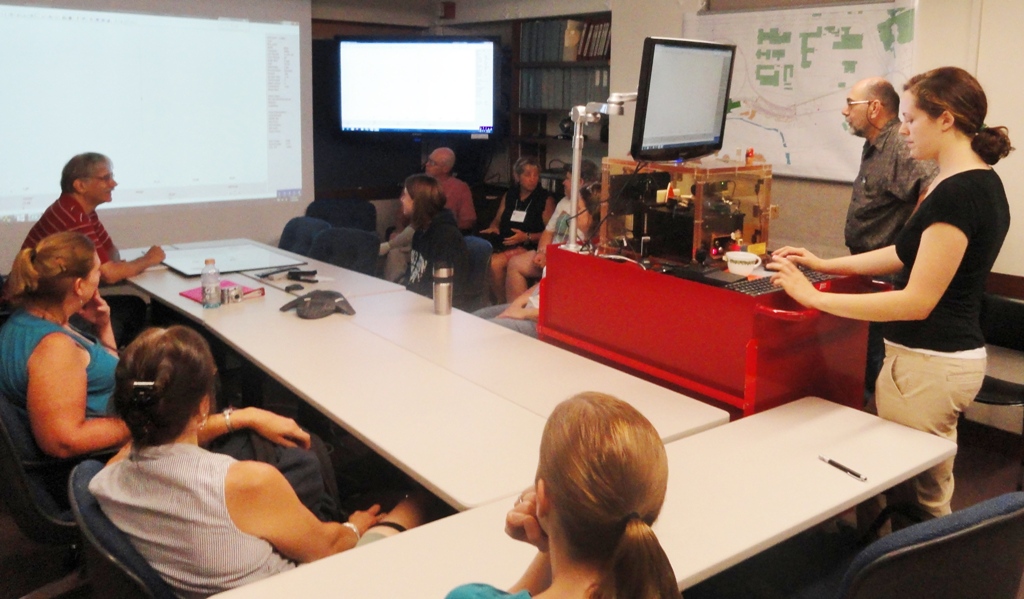X-RAY RUNS: Apply for Beamtime
2017 Nov 1 - Dec 21
2018 Feb 7 - Apr 3
2018 Proposal/BTR deadline: 12/1/17
2018 Apr 11 - Jun 4
2018 Proposal/BTR deadline: 2/1/18

REU student Logan Baum presents his summer research results.
By Erik Herman, Ernie Fontes - August 2010
CHESS was fortunate this year to have five talented undergraduate students visit for the summer and help carry out development projects related to x-ray science, instrument development, and outreach and education activities. Four of these students – Tia Plautz (Cornell), Katherine Spoth (SUNY Buffalo), Logan Daum (M.I.T) and Miriam Robinson (Lewis and Clark) - were among the dozen drawn to Cornell as participants in a Research Experiences for Undergraduate (REU) program sponsored by the National Science Foundation and organized by Cornell professors Georg Hoffstaetter and Ivan Bazarov. Gathered from across the United States, these students undertook projects covering the gamut of the REU proposal title – “Accelerator Physics and Synchrotron Radiation Science” - in residence at the Ithaca campus for ten weeks doing research, attending seminars and formal lectures, taking tours of research facilities, enjoying social and recreational events, and presenting their research at a forum at the summer’s end during which participants present the results of their research. The fifth x-ray project student, Jennifer Kenkel (Washington University, St. Louis), is an Ithaca resident who filled a summer science internship position sponsored by CHESS.

(From left) Tia Plautz, Jennifer Kenkel, Katherine Spoth, and Miriam Robinson after giving formal presentations to the CHESS audience.
Tia Plautz, an undergraduate from home-town Cornell University, worked with capillary optics group at CHESS led by mentor Don Bilderback, CHESS Associate Director. This group designs and fabricates tapered glass capillaries used to focus x-ray beams down to microns in size, which are used by many scientists and users at CHESS to achieve spatial resolution data from a variety of specimens. Tia’s challenge was to write MATLAB programs to simulate shapes of tapered glass capillary and then launched photon “rays” that bounced off the glass, traveled through the focus, and proceeded to a far-field camera. For years the group had seen far-field images that were less than perfect and did not know the root cause of those imperfections. Tia was asked to model three types of defects in capillaries, periodic ripples, “banana-shaped” curvature, and figure error (like a flattened tip). Using this model to simulate far-field images, Tia proved that the curvature defects were mostly responsible for larger focused spot sizes and loss of performance of the capillaries.
An undergraduate at Cornell, Tia was already familiar with the campus but her summer experience was entirely new and exciting. Whether yoga or violin, literature or physics, Tia is constantly pushing herself and her research studying capillary optics was a welcomed challenge. Though adept at learning complex concepts in a classroom, from a text, or in a lab class where the outcome is already known, this summer she enjoyed the thrill of charting new territory and learning directly from what she was studying.
Tia had found out about REU from her Quantum Mechanics professor. As many students will attest, the first week was a bit overwhelming. She didn’t know anybody, there was a lot to learn, and there was a busy schedule with talks every day. It helped that she had already met and felt at ease with mentor Bilderback.
Tia started by modeling a capillary with an inner surface that approximates the shape of an ellipse and, therefore, is able to focus x-rays down to a tiny spot. Ripples and other defects inside the capillary have an adverse effect on focusing. It is difficult to observe this surface directly, for instance with a microscope, because the capillary itself bends light. Tia’s challenge was to mathematically model how these rays reflect off the inner surface of the capillary so that, from rays that exit the capillary, the inner surface contour can be inferred and adjustments can be made in fabrication. She spent many grueling hours learning a computing language but it paid off when she was able to design a tool that correctly modeled the geometries of the optics. It was quite gratifying to then be able to use this tool to solve problems that would have otherwise been unsolvable.
REU student Tia Plautz explains her work analyzing x-ray capillary
optics to a group of attentive visiting high-school teachers.
With an interest in education and communicating her love of Physics with others, she was also delighted to have plenty of opportunities to present her research to groups of visiting teachers. In a way, it gave her a chance to give back to the many teachers that inspired her. During her REU summer she discovered that research can be very different from classes, homework and grades. Instead of deadlines, you immerse yourself in the phenomenon until you understand it. Instead of competition, everyone works together because they’re trying to figure out how things work too. About being stuck in a laboratory? She loved being able to focus on something for six to eight hours at a time; she’s actually going to miss it as she heads into her Senior year, but she’s already looking forward to graduate school.
Tia will continue this project into her next academic year. Future work will include modeling a tapered capillary designed to work on the microfocus beamline at the Advanced Photon Source. The goal for this work is to update the model to consider a full three-dimensional ray trace, create a user GUI and web interface to make the model much easier and accessible. “A 3D model is really needed to go the full way understanding all possible problems and capillary performance limitations,” says Bilderback. This work will go a long way to testing and improving our intuitions about focusing with tapered glass capillaries.

Phase contrast image of a wasp collected by CHESS graduate student Robin Baur,
with help in processing by REU student Miriam Robinson. The Talbot
Interferometer is able to strongly accentuate the boundaries between
biological tissues having different densities.
Miriam Robinson worked with CHESS graduate student Robin Baur and staff scientist Darren Dale to construct a model of phase contrast imaging using a home-built Talbot Interferometer. The Talbot Interferometer is a fairly new instrument at CHESS that allows full field imaging of small objects with very high spatial resolution, allowing scientists, for example, to see the respiration channels inside insects. Contrast in standard x-ray images, like one would find in a doctor's office, is produced by variations in the absorption of x-rays by an object. Biological tissues absorb x-rays only weakly, so x-ray images only detect dense objects or relatively large features. Phase-contrast x-ray imaging, in comparison, is more sensitive to small variations in density, and thus provides a more powerful window into the structure of weakly-absorbing objects at the micron scale (see photo above). Although phase-contrast imaging techniques are often performed at highly-brilliant synchrotron light sources such as CHESS, some techniques can also be done with sufficiently powerful x-ray tube sources coupled with microfabricated x-ray optics.
Miriam’s help was needed to model a new microfocus x-ray source (soon to arrive at CHESS) to determine the possible resolution and sensitivity and how to do image analysis. She calculated the Fresnel diffraction and magnification for a range of phase gratings and showed that they could realize a 2.3 micron spatial resolution with images having contrast as low as 3%. She ran a Monte Carlo simulation with noise to estimate the sensitivity and uncertainty. To test this method, she modeled taking images from a bee captured in amber. Her analysis showed how to relate the required contrast and resolution to the number of images required.
This was Miriam’s first physics research experience. Miriam had little difficulty adjusting to Ithaca weather—it’s about the same here as it was home in Seattle—but she was pleasantly surprised by how friendly everyone is. She quickly made friends and even joined Ithaca’s Ultimate Frisbee summer league. It wasn’t easy for her to explain to her parents and friends what a synchrotron was or how she would be using its x-rays to see things. It was exciting for her to be around so many physicists. None of her friends from Portland, Oregon, where she will be a junior in Physics, Math, and Computer Science, are physics people. Lewis and Clark is a small school with a small physics department so she found it pretty overwhelming to be immersed in such a huge laboratory environment with so many people. It was probably good that her desk was in a secluded area down in the G-Line so that she could focus on her work.
It was difficult trying to catch up on everything her mentors had already accomplished. There’s so much mathematics involved that Miriam spent much of her time studying and reading a lot of articles. The most challenging part of the experience for her was the presentations she had to give. She admitted that she didn’t like public speaking, but you wouldn’t know it to see her. Asked what she’ll miss the most as she heads back to Portland, she pines “not being around people who actually know what I’m talking about”.
Katherine Spoth worked with CHESS staff scientist Peter Revesz to learn about x-ray fluorescence and how to make it usable and useful as a teaching tool for visiting K-12 students and teachers. CHESS has recently developed a mobile X-Ray Fluorescence (XRF) unit with the express purpose of allowing demonstrations even when the synchrotron x-ray source is not running. With XRF one can easily analyze the near-surface composition of almost any solid object. The method of XRF is especially sensitive in discovering heavier elements which are often part of harmful or toxic substances often found in ordinary household items. Katherine mastered the use of the mobile XRF station, mounting specimens on the joystick-controlled scanning stage, taking histogram spectra, and systematically scanning specimens for instructional purposes. She discovered inherent limitations, including not being able to measure light-element fluorescence because of air absorption. She tested many common objects - about 100 in total -looking for heavier elements and toxins in common objects such as decorative painted curios to children’s toys and beads.
Katherine Spoth (right) and CHESS staff scientist Peter Revesz (second from right) use the portable x-ray fluorescence station (red cart) to demonstrate x-ray analysis to a group of visiting middle school teachers participating in the Cornell Institute for Biology Teachers
Katie’s first few days here were stressful. It was her first time away from home, and her first time doing serious research. One of the safety orientation sessions she attended emphasized how important it was to not enter certain areas because of high voltage and harmful radiation, but she kept getting lost. Whenever she headed up or down the stairs she never knew where she might end up and whenever she walked through a doorway she didn’t know what alarms she might trigger. To make matters worse, it seemed especially difficult in the beginning to find her mentor’s office in the busy CHESS trailer.
It was refreshing to discover that the equipment she would be spending most of her time with—complete with a warning picture of the radiation symbol, a skull and crossbones, and someone running away—was actually fail-safe. It took a few days to get used to it, and things didn’t always work correctly, but eventually Katie was looking at anything and everything through the eye of an XRF analyzer. It was a bit lonely, just her and this machine, but things got better when another undergraduate, Jenny, arrived to share the space—the two became instant friends.
XRF results when an atom is exposed to high energy light and its electrons are excited such that they leave their inner low-energy shells, creating vacancies for outer electrons to fall into. When the outer electrons fall they emit photons, or fluoresce, at energies specific to each single element. This allows the researcher to determine exactly what elements are present in a sample. Once Katie realized what a powerful tool she had mastered, she began looking at public health high-interest items such as soil, cosmetics, jewelry, and face-paint for the presence of harmful elements. Lucky for us she didn’t find much there. When she was almost running out of ideas she placed into the machine an item she had been using daily to drink out of—her grandmother’s coffee cup. It quickly became her most interesting specimen. The lovely green decorative paint contained alarmingly high amounts of lead.
Lots of work and worry didn’t stop Katie from going out dancing many nights. She had joined Ithaca’s strong swing dancing community and as the president of the swing dancing club at SUNY Buffalo, she can tear up the dance floor, lead poisoning or not. Before this summer Katie didn’t really know if she wanted to be a research scientist, but now that she’s had the opportunity to do what scientists actually do, it turns out that she really enjoys it.
Logan Daum worked with MacCHESS staff scientist David Schuller to develop a graphical user interface (GUI) for moving motors at the D1 experimental station. Moving motors via computer control is the main method used to automate x-ray data collection at synchrotron sources, since it allows specimen manipulation inside the closed x-ray shielded rooms while the experimental scientists sit outside at the control station. Logan accomplished his project by mastering something called “SPEC sockets”, a software protocol that allows remote computers to send requests and receive responses from the computer running the SPEC server software. The SPEC computer has the actual hardware interface to the motor and is the only computer able to actually perform the movement. All other computers are clients and, using software Logan built, send request to the SPEC computer to create motions.
Making the user interface to a motor a visual experience is necessary to speed up the alignment of specimens and make the data collection process more user-friendly and less exhausting. Using SPEC sockets, Logan designed a general purpose communications channel that allows multiple software packages to direct/change the specimen stage. He was able to reuse Java software previously written for a video camera interface used at the macromolecular crystallography stations. The GUI used buttons and dials to move motors of the translation stage, camera focus, and lighting. SPEC server lets outside applications send commands through TCP packets to control motors, read values, etc. He tested socket communications in C++, Phython, and Java. Logan rebuilt the motor plug-in from the prior application but he retained capabilities so that future expansions (or upgrades) are possible. He added new features, like selecting motors inside the GUI menu, enabling or disabling motors, scaling factors, and preset zoom and focus settings. Future work could include controlling the x-ray shutter, tracking the state of the shutter, and a button which would simultaneously save both a diffraction image from the detector and a photographic image of the sample.
Logan got a fast start on his complicated project because Python was easy for him since he had used it extensively in his previous year’s REU assignment doing simulations for LIGO at Caltech. More challenging was learning Java, but, after three days of debugging code late into the night he knows it quite well. While other REU students were nervously adjusting to their new environment at CHESS, with new people and new projects, medications prescribed for a wisdom tooth extraction helped Logan remain calm and relaxed during the first few days of his research experience.
An avid runner, he would sometimes tear himself away from the computer and escape to the beautiful trail system north of Campus. After spending most of the year surrounded by concrete at MIT, where he is entering his Senior year studying Physics, Chemistry, and Engineering, he found it refreshingly easy here to get out of sight of a building or sidewalk. Indeed, Ithaca is a bit more like his home in Fairbanks, Alaska than Boston. When it came to getting a simple item from the supermarket, though, he had to make sure he was riding shotgun when the only REU student with a car was headed into town. Logan has made some great friends here whom he plans to stay in contact with.
The hours he spent working on the GUI paid off handsomely. During and after his presentation of results to the CHESS staff, scientists were already making plans to use apply his software in imaginative ways at their experimental stations.
Jennifer Kenkel was in a unique situation—coming home from college to go to Cornell for the summer. She attends Washington University in St. Louis, but she grew up here in Ithaca. It was nice getting to see her parents and old friends, but it was also great to make new ones, especially her lab-mate Katie, as part of her experience at Wilson Laboratory.
It was a bit odd not knowing anybody and not knowing where anything was. On her first day, she and her mentor, MacCHESS scientist Richard Gillilan, read through and talked about journal articles that had been written mostly in the language of mathematical equations. She found it a bit scary that he seemed to completely understand it. Even more intimidating was that she had to present her research, more than a few times, to a whole room full of scientists and engineers. “That was kind of high-pressure. I mean, these guys know so much and they’d ask me questions that they probably already knew the answers to.” It looked like this was going to be a lot of work.
Things got much easier when Jenny realized that no one is expected to know everything. In fact, everyone seemed to understand a different piece of the puzzle or they understood the same piece in a different way. The staff relies heavily on teamwork to get things done, she learned firsthand. There are also no arbitrary deadlines here at CHESS. At school she was used to getting assignments and they’re due on a certain day. “Here you work hard to do it, and it’s done when it’s done.”
Jenny’s research involved designing a mechanical stand to hold an x-ray “slit” and rotate that slit through three degrees of freedom. X-ray slits are assemblies that use opaque metallic blades to act as an adjustable aperture, typically used to define a small x-ray beam by blocking out unwanted portions of a larger incident beam. She used her new mechanical stage and new optical table to test different types of slits in order to find out which scattered incident x-rays the least.
She found the hardest part of her research experience to be the high level of independence in the learning process. “When was it appropriate to call on my mentor and say, I’m stuck? On the one hand, it really isn’t useful to spend time frustrating yourself, but on the other it can be really valuable to struggle and work through problems”. In fact, she often found it truly rewarding to figure things out by herself. “I don’t know if other people get inspired by math problems, but I did”. It was also gratifying to make real things that work. She described how one day she measured an adapter plate, drew up the sketch, drilled out some holes, tapped them, aligned it to thousands of an inch which, she pointed out, “is a huge ordeal”. When Jenny was finished, she sat back and admired her creation.
As Jenny enters her sophomore year she intends to change her major from “undeclared” to Math and Physics.
Further information about the REU program, with links to project presentations, can be found at:
http://www.lepp.cornell.edu/Education/REU/WebHome.html


